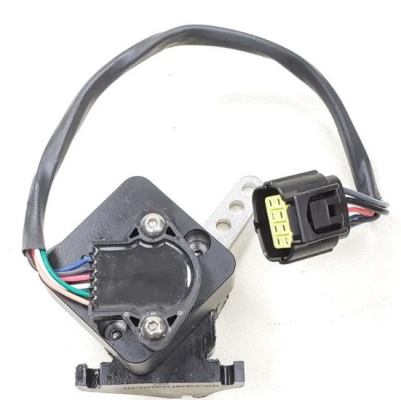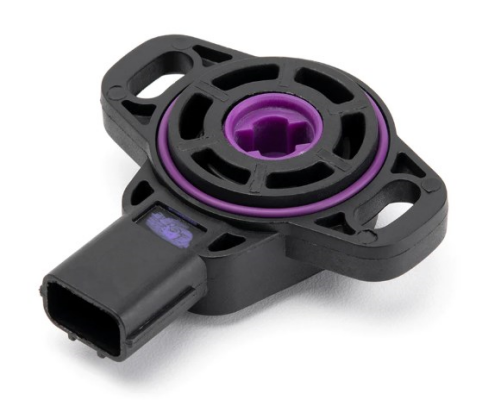OUTLINE:
How to Throttle Position Sensor For Beginners
 154
154Have you ever been in a situation where the accelerator failed while you were driving?
It's an annoying thing to have a car malfunction like this, especially on the highway. So what's causing the throttle to fail? It could be related to a widget of automotive electronic control system - the throttle position sensor.
Here, we’ll go through what a TPS is and what is its function. Then this article will offer you two methods of checking TPS.
Hopefully, you will know exactly how to check if throttle position sensor is bad after reading.

What Is A Throttle Position Sensor
A throttle position sensor (TPS) is a crucial component in a vehicle's engine management system. It's responsible for monitoring and conveying the position of the throttle to the engine control unit (ECU) or powertrain control module (PCM).
Essentially, the TPS detects how far the throttle is open or closed and translates this information into electrical signals.
More specific information about the throttle position sensor is explained in the next section.
Types of Throttle Position Sensor
Throttle Position Sensors (TPS) are crucial components in modern engines, providing information about the throttle's position to the engine control unit (ECU). They come in a few different types based on their design and mechanism of operation:
Potentiometer-Based TPS
It utilizes a potentiometer to provide a variable resistance based on the throttle position.
As the throttle opens or closes, the resistance changes and the TPS sends a voltage signal to the engine control unit (ECU) to adjust fuel injection and ignition timing.

Hall Effect TPS
Hall effect sensors use a magnetic field to determine the throttle position.
As the throttle moves, it changes the magnetic field, and the sensor detects this change.

What Is the Function of A Throttle Position Sensor
The primary function of the TPS is to monitor and relay the position of the throttle plate or pedal to the engine control unit (ECU).
It provides real-time information about how much the throttle is open or closed, indicating the driver's desired power output.
The TPS signal is used by the ECU to adjust the air-fuel mixture in the engine. As the throttle opens or closes, the ECU uses the TPS input to determine the appropriate amount of fuel to inject into the combustion chambers, ensuring efficient and optimized fuel combustion.
How to Check Throttle Position Sensor(2 Methods For You)
Method 1: Check Throttle Position Sensor with Multimeter
For measuring electrical resistance and voltage,a multimeter is a good tool while checking the throttle position sensor. So let's study how to check TPS with it.
Preparation: Turn off the vehicle and disconnect the battery for safety.
Locating TPS: Find the Throttle Position Sensor (TPS) usually on the throttle body.
Disconnecting TPS: Remove the electrical connector from the TPS.
Resistance Check: Set the multimeter to measure resistance. Connect leads to TPS terminals. Gradually move the throttle; resistance should change smoothly.
Voltage Check: Set the multimeter to DC voltage. Reconnect the TPS. Connect multimeter leads to appropriate terminals.
Turn the ignition to "ON." Gradually open the throttle; the voltage should change smoothly.
Referring to Manual: Consult the vehicle service manual for expected resistance and voltage values.
Intermittent Checks: Wiggle wiring while monitoring for changes.
Replacement: If readings are irregular, consider replacing the TPS following the service manual.
Method 2: Check Throttle Position Sensor with Scan Tool
Checking the Throttle Position Sensor (TPS) with a scan tool is a relatively straightforward process. Here are the general steps you can follow:
- Connect a scan tool to the OBD-II port in your vehicle.
- Access the live data or sensor data section and locate the Throttle Position Sensor (TPS) parameter.
- With the engine off, observe the initial throttle position reading.
- Start the engine and monitor the TPS reading as you gradually open and close the throttle. The values should change smoothly without sudden jumps or drops.
- Check for any error codes related to the TPS.
- Compare the actual readings with the expected values specified in the vehicle service manual. If the TPS readings are inconsistent or outside the specified range, it may indicate a problem, and you should consider replacing the TPS.
The Signs that the Throttle Position Sensor Is Bad
A faulty Throttle Position Sensor (TPS) can lead to various performance issues in a vehicle. Here are some common signs that may indicate a bad TPS:
Poor Acceleration: Sluggish or hesitant acceleration, especially when you press the gas pedal, may indicate TPS problems.
Uneven Idling: Fluctuations in engine idle speed or stalling when the vehicle is stationary can be a sign of TPS issues.
Surging or Bucking: If you experience abrupt surges or jerks during acceleration, it could be due to erratic TPS readings.
Inconsistent Speeds: Difficulty maintaining a consistent speed, particularly at highway speeds, may be attributed to TPS irregularities.
Transmission Shifting Issues: Incorrect TPS signals can affect automatic transmission shifting, leading to harsh or erratic gear changes.
Poor Fuel Economy: A failing TPS might contribute to inefficient fuel delivery, resulting in decreased fuel efficiency.
Check Engine Light (CEL) Activated: The onboard diagnostics system may detect TPS issues and trigger the Check Engine Light on the dashboard.
Sudden Changes in RPM: Unusual and sudden changes in engine RPM (revolutions per minute) when the throttle is applied or released can indicate TPS problems.

FAQs
Can a bad throttle body affect transmission
Transmission Trouble? Not Likely: A bad throttle body usually minds its own business when it comes to your transmission. The main concern is with airflow, not gears. However, rough engine running caused by the throttle body can confuse the transmission and lead to some jerky gear changes.
What happens if I unplug throttle position sensor
Unplug the TPS Sensor? Don't! The throttle position sensor (TPS) is like the gas pedal translator for your engine computer. Unplug it, and things get messy. Expect power loss, erratic idling, and a glowing check engine light as the computer struggles without the TPS signal.
Does throttle body affect fuel
The throttle body plays a key role in fuel economy. It controls airflow, which works hand-in-hand with fuel for combustion. A faulty throttle body can mess up this balance, leading to inefficient fuel use. Additionally, a high idle due to a bad throttle body burns extra fuel even when you're not going anywhere.
Conclusion
Diagnosing a Throttle Position Sensor (TPS) involves a systematic approach to ensure accurate identification of potential issues. Utilizing an OBD-II scanner to access live data and observe TPS readings during various throttle positions is crucial.
Smooth and consistent changes in values, absence of sudden fluctuations, and adherence to specified ranges are indicative of a properly functioning TPS. Any irregularities, accompanied by symptoms like poor acceleration, uneven idling, or transmission issues, should prompt further inspection and potential replacement of the TPS.
Regular monitoring and proactive maintenance contribute to optimal engine performance and fuel efficiency. If uncertainty persists, consulting with a qualified mechanic or automotive professional ensures a thorough diagnosis and effective resolution of TPS-related issues.

Disclaimer: The views and opinions expressed by individual authors or forum participants on this website do not represent the views and opinions of Chipsmall, nor do they represent Chipsmall's official policy.

share this blog to:

